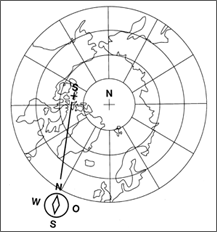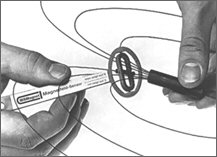
The deviation of a compass
The earth is a gigantic magnet, with a North Pole and South Pole. As a permanent magnet it is surrounded by a magnetic field.
Since the North Pole of a magnet refers to the North, and because opposite magnets attract each other, the geographic North Pole is a magnetic South Pole.
The geographic and magnetic poles are not at the same location. The magnetic South Pole is situated in the north of Canada, about 1000 km away from the geographic North Pole. The needle of the compass does not therefore point directly to the North. This deviation of the compass needle is different at every place on earth. In Germany the angle of deviation is currently 2.5°.
This deviation is caused by the continual and slow shifting of the magnetic poles. Measurements have shown that the magnetic South Pole moved more than 190 km to the Northwest within the five years from 1995 - 2000. Analyses of volcanic rock have revealed that the earth's magnetic field has reversed its polarity several times.
The strength of the earth's magnetic field varies over the entire surface. It is diverted or shielded by the magnetic conductive metals contained in the crust of the earth such as nickel, iron and cobalt. At the poles, the magnetic field is strongest. The magnetic field of the earth is weak compared to the magnetic field of a permanent magnet.
A small permanent magnet made of rare-earth metals, such as DeltaMagnet (SmCo) and NeoDeltaMagnet (NdFeB), supplied by IBS Magnet, has a field which is several thousand times stronger.

A small magnet and the needle of a
compass follow the magnetic flux lines.
(IBS Magnet field sensor Type MK II)
The magnetic flux lines of the geo-magnetic field radiate from the surface of the globe in different angles relative to the polar axis.
The flux lines surrounding permanent magnets also have a curved course on their flow from South to North Pole. Since the inclination of a small rod magnet follows those flux lines in the same way as the needle of a compass, we can see the pattern of a magnetic field with the field sensor, Magnaprobe MK II. This applies to the extension of the field as well as to its direction.
Magnetism is a mysterious force. We can neither see nor feel it. Our senses do not perceive magnetism.
Magnetism has been known to mankind for millennia. The nautical compass with a steel needle has been in use since 1250 BC.
Magnetism has continually inspired technicians and scientists to invent new applications. The newest generation of high-energy magnets made of rare earth metals has made many more technical applications possible, e.g. the magnetic levitation railway.
Opposite poles attract each other
Equal poles repel each other
 Know-how
Know-how  Magnetism
Magnetism



